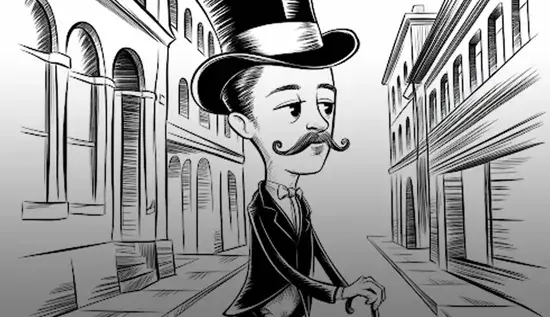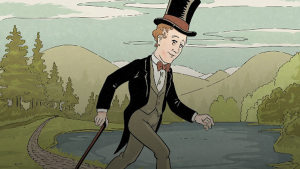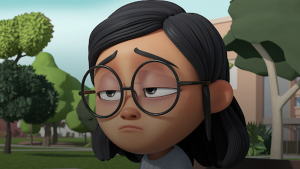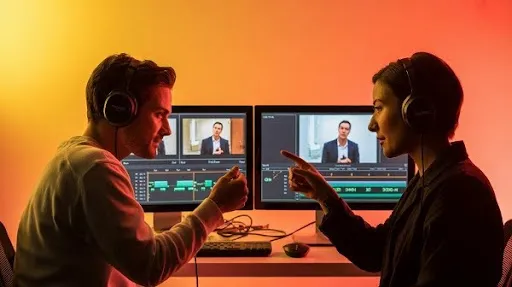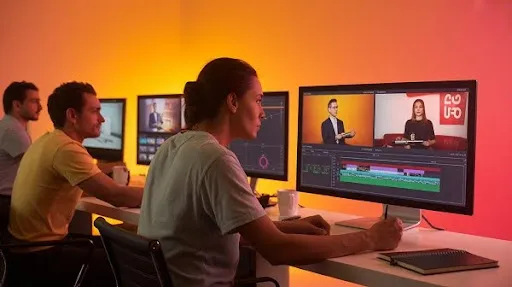Similar to other industries in our world today, animation technology has also seen unprecedented evolution over the Twokart era from frame-by-frame to hand-drawn techniques and then contemporary computer-assisted motion. One of the most notable leapfrogging steps in the animation industry has been the invention of tweening, a technique that enables smooth changeovers between keyframes whilst taking much heat off animators—making it essential for mastering fluid motion.
But where did tweening originate? How has it evolved from traditional cel animation to the digital animation techniques used today? This article sheds light on the focus of this essay, tween history chronicling its highlight from the golden era of animation to the present-day digital world.
1. The Origins of Tweening in Traditional Animation
Early Animation & The Birth of In-Betweening
Before the 1900s, hands were the main tools for performing traditional animations. Every movement of a character had to be drawn and worked on individually, frame by frame, which was not just tedious but also expensive.
🔹 The Invention of Keyframe Animation:
Experimenters such as Winsor McCay, known for his work Gertie the Dinosaur (1914), and Otto Messmer with Felix the Cat, started drawing keyframes where only an important frame, also known as a pose, was generated. The missing frames were filled in manually to create smooth movement—a technique that later sparked discussions on whether frame-by-frame methods or automated in-betweening offer the best results.
🔹 How In-Betweening Was Born:
In the 1920s, animation goliaths like Disney and Fleischer Studios pioneered the employment of assistant animators, later known as ‘In-Betweeners.’ They were responsible for sketching the fluidity-filled transitional frames to a keyframe generated by an animator.
From that moment, tweening (in-betweening) became and remains an essential component of the animation process, alleviating the burden on principal animators and keeping the motion smooth. While often compared to morphing for its ability to create seamless transitions, tweening has distinct applications that make it indispensable in animation.
2. The Golden Age of Animation & Tweening’s Evolution
The Golden Era of Animation, known as the Golden Age of Animation, the 1930s to 1950s, had Disney, Warner Bros. and MGM Animation Studios at the forefront of the altercations made within the domain of animation. During this period:
✅ Cel animation became the standard, using layers of transparent sheets to animate characters over static backgrounds.
✅ More advanced in-betweening techniques were developed to create fluid, lifelike movement.
✅ Disney introduced the “12 Principles of Animation”, which included techniques like ease-in and ease-out, still widely used in tweening today.
🎬 Examples of Tweening in Early Cartoons:
- Snow White and the Seven Dwarfs (1937) – Disney’s first feature-length film relied heavily on tweening for natural character movement.
- Looney Tunes (1940s-50s) – Warner Bros. used advanced pose-to-pose animation, an early form of motion tweening.
Even though manual in-betweening was still dominant, studios sought ways to automate the process—leading to the next major shift in animation history.
3. The Rise of Computerized Tweening (1960s-1980s)
The Introduction of Computer-Assisted Animation
By the 1960s, the first computer-generated animations began emerging, with early experiments in automated frame interpolation (an early form of digital tweening).
🔹 The First Use of Computerized Tweening:
- One of the first applications to introduce CAD in-betweening was Ivan Sutherland Sketchpad in 1963.
- From the 1970s onwards, scan and paint systems came into use, which were later succeeded by digital tweening methods during the 1980s.
💡 By the 1980s, studios have started to automate tweening and reduce the necessity for inbetweeners.
4. The Digital Age of Tweening (1990s-Present)
The 1990s to today has seen animation evolve from hand-drawn processes to fully digital workflows, thanks to software-driven tweening.
The Introduction of Digital Tweening Tools
By the mid-1990s, software like Adobe Flash (now Animate) revolutionized animation by offering automated motion tweening, shape morphing, and path-based movement.
🔹 Major Breakthroughs in Tweening Technology:
- 1996: Macromedia Flash – Introduced vector-based tweening, making animation easier and faster for the web.
- 2000s: Toon Boom & After Effects – Added advanced keyframe interpolation with motion graphics.
- Present Day: Blender, Maya, & Unity – Utilize skeletal tweening (rigging) and AI-powered motion interpolation for smoother, more realistic animations.
5. How Tweening is Used in Modern Animation
Today, tweening is a standard feature in all major animation tools, whether for 2D motion graphics, 3D character rigging, or video game development.
Modern Tweening Techniques & Applications
📌 Motion Tweening in 2D Animation:
- Used in software like Adobe Animate & Toon Boom
- Ideal for character movements, background transitions, and UI animations
📌 Skeletal Tweening in 3D Animation:
- Rigging systems in Maya & Blender
- Essential for game animations, CGI films, and motion capture
📌 AI-Powered Tweening in Gaming & VFX:
- Machine learning algorithms now create automatic in-betweens, reducing manual work.
- Game engines like Unity & Unreal use real-time tweening for character animation.
🚀 To see how tweening is used today, check out our modern tweening techniques.
6. The Future of Tweening in Animation
With advancements in artificial intelligence, real-time rendering, and machine learning, the future of tweening is more automated and efficient than ever.
What’s Next for Tweening?
🔹 AI-Powered Tweening: Machine learning tools like DeepMotion and Rive use AI to automate tweening for ultra-realistic motion.
🔹 Procedural Animation: Used in game engines to generate dynamic in-between frames on the fly.
🔹 VR & AR Tweening: With the advancements in virtual reality, tweening will be exceptionally useful for 3D interactions.
💡 For a deep dive into tweening in modern animation, read our tweening tutorial.
FAQs
When was tweening first used in animation?
Tweening started in the 1920s at Disney and Fleischer Studios with keyframe animation. Early animators drew the main action frames (keyframes) first, and the ends of sequences were animated by so-called “inbetweeners” who made movement more fluid.
📌 This Postmanual in-betweening approach was established during the golden age of animation 1930-1950.
What was the first animated film to use tweening?
The 1937 Disney animated film Snow White and the Seven Dwarves was the first feature-length animated film to use tweening. It used a lot of in-betweening so the character movements could be fluid and smooth.
✅ Other early examples of tweening techniques:
- Steamboat Willie (1928) – One of the first cartoons using synchronized sound with animated movement.
Looney Tunes (1940s-50s) – Used a combination of pose-to-pose animation and in-betweening to reduce labor.
What role did Disney play in refining tweening techniques?
Disney pioneered several advancements in tweening through:
✅ The "12 Principles of Animation" – Established in 1981 by Disney animators Ollie Johnston & Frank Thomas, including:
- Ease-in & Ease-out (important for tweening motion).
- Squash & Stretch (used to create natural movement in in-between frames).
✅ The Multiplane Camera (1937) – Allowed depth in animations, making tweening more dynamic.
✅ The Use of Assistants ("In-Betweeners") – Helped streamline the animation workflow and reduce production time.
📌 For a deep dive into tweening in modern animation, read our tweening tutorial.
How did computerized tweening start in animation?
Tweening became partially computer-assisted in the 1960s and 70s. Some key milestones include:
💡 1963: Sketchpad by Ivan Sutherland – One of the first software to introduce computerized keyframe animation.
💡 1974: The first digital morphing animation – Early motion interpolation techniques led to the development of digital tweening.
💡 1980s: Disney’s CAPS system – A computer-assisted post-production process for digital ink-and-paint, incorporating automated tweening.
Animation made a boom in the 1990s with the portentous releases of Macromedia Flash and Toon Boom Harmony, which provided tremendous opportunities for animations due to the availability of built-in tweening tools.
How did Flash animation impact tweening in the 1990s and 2000s?
The rise of Macromedia Flash (now Adobe Animate) in the late 1990s changed animation by:
✅ Introducing motion & shape tweening for web-based content.
✅ Allowing animators to create animations with fewer frames.
✅ Popularizing tweening for online cartoons and YouTube animations.
🎬 Examples:
- Homestar Runner (2000s)
- E-Surance Animated Ads
- Early YouTube animations & Newgrounds content
📌 To see how tweening is used today, check out our modern tweening techniques.
What is skeletal tweening, and how did it change 3D animation?
Skeletal tweening, or rigging, emerged in 3D animation during the late 1990s and early 2000s, allowing animators to:
✅ Attach bones (rigs) to 3D characters.
✅ Animate joints and limbs independently instead of frame-by-frame movements.
✅ Use motion capture data to create lifelike movement.
📌 Examples of Skeletal Tweening in 3D Animation:
🎮 Toy Story (1995) – The first fully 3D animated film using skeletal tweening.
🎮 Shrek (2001) – Used rigging-based animation for character expressions and body movements.
Today, software like Blender, Maya, and Unity use skeletal tweening in gaming, film, and virtual reality projects.
How does AI-powered tweening work in modern animation?
AI-powered tweening uses machine learning algorithms to:
✔ Automatically generate in-between frames based on motion prediction.
✔ Apply real-time motion interpolation for smoother animations.
✔ Improve animation speed and reduce manual labor.
💡 Examples of AI-powered Tweening Tools:
- DeepMotion AI – Uses machine learning for automatic in-betweening.
- Unreal Engine's Motion Matching – AI-assisted tweening for game animation.
🚀 Want to learn more? Read our modern tweening techniques guide.
What industries use tweening today?
Tweening is widely used in:
🎬 Film & TV Animation – Pixar & DreamWorks use tweening in 3D animations.
🎮 Gaming – Used for character animation, cutscenes, and UI effects.
📱 Mobile UI & Web Animation – Websites and apps use tweening for smooth interactions and transitions.
🎓 E-learning & Training Videos – Motion tweening helps create engaging animated educational content.
Is manual tweening still used in the digital era?
Yes! While digital tweening has automated many aspects of animation, manual tweening is still used for:
✔ Anime & hand-drawn animation – Studios like Studio Ghibli often combine traditional in-betweening with digital tools.
✔ Stop-motion animation – Some elements require manual frame-by-frame adjustments to maintain fluidity.
✔ Hybrid Animation – Many productions blend frame-by-frame and digital tweening for more expressive movement.
How can Prolific Studio help with professional tweening animation?
At Prolific Studio, we provide:
🎬 2D & 3D Animation Services – For marketing, branding, and storytelling.
🎮 Gaming Animation & Character Rigging – Custom tweening for smooth, engaging game animations.
📱 UI/UX Motion Graphics – Bringing interactive web and mobile designs to life.
📌 Need high-quality animation? Contact Prolific Studio today for a free consultation!
Final Thoughts
Tweening has played a critical role in animation history, evolving from hand-drawn frame-by-frame techniques to AI-driven animation. Mastering the nuances of smooth motion through tweening allows animators and studios to maximize efficiency and improve motion quality.
📌 Want to explore tweening techniques in-depth?
👉 Read our complete tweening animation guide for best practices and tools!
🚀 Need professional animation services? Prolific Studio, one of the best animation studios in LA, is here to bring your vision to life! Contact us now. 🎬✨

